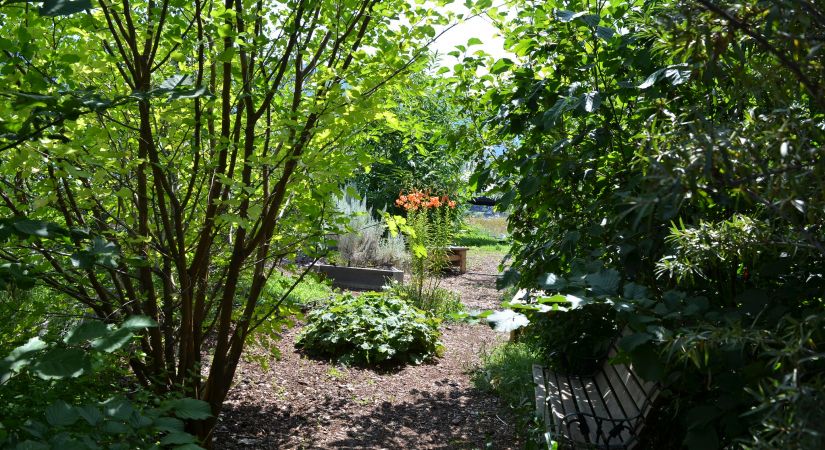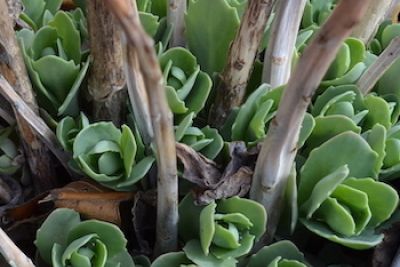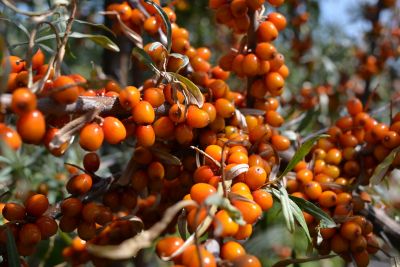
Kalamalka Indigenous Garden brings community together in Vernon
Stepping along the bark mulch path of K'nmaĺka? Sənqâĺtən, navigating through the dense brush of salmon berry and olive trees, visitors get a rare opportunity to step into a space filled with traditional plants significant to Syilx Okanagan people.
K'nmaĺka? Sənqâĺtən (Kalamalka Garden) is an Indigenous garden created in 2017 through a unique collaboration among the Okanagan Indian Band (Elders and community members), Okanagan College and the Food Action Society of the North Okanagan. The garden has resulted in a tranquil and serene space where tradition, knowledge and learning meet so Syilx Okanagan culture can flourish for generations to come.
Garden springs to life with help from many

While the garden is part of Okanagan College's Indigenous initiatives and championed by the campus' Indigenous Coordinator, this garden is a community project that has been supported by Food Action staff, Okanagan Indian Band (OKIB) members, volunteers and community organizations.
Kalamalka Garden is located at the Vernon campus of Okanagan College, adjacent to Patchwork Farms. It contains indigenous food plants from the Okanagan territory, as well as other native species indigenous to this area, and it was developed to be a community teaching resource of region's indigenous plants used by OKIB.
The work in the garden during 2017 focused on the initial construction of the garden beds from recycled materials and pathways and on the installation of the first plantings. Elders, family and Indigenous students gathered medicinal and food plants from the traditional Okanagan lands to transplant into the garden. During that year, short workshops presented by OKIB members on medicinal plants and on the origins of the sweat lodge were held.
The name of the garden has special meaning. Theresa Dennis, an Elder from the lower Similkameen Indian Band, provided the name and title of the medicine garden. She was born and raised on the Okanagan Indian Band and is a fluent Syilx Okanagan language teacher.
- K'nmaĺka? is the Syilx Okanagan name of Mary K'nmaĺka?, one of the nation's late Elders who the beautiful and colourful Kalamalka Lake was named after.
- Sənqâĺtən means a place to plant food and herbs.
Plants and traditional uses

The garden features many plant species including:
- echinacea
- hawthorn
- flowers
- brush
- olive trees
- wolf willow
- garden sage
- French tarragon
- kickinnick
- raspberry bushes
- fruit-bearing shrubs
- sage
- blueberries
The garden was carefully planned, benefiting from traditional ways of knowing and doing: medicine plants thrive when placed next to their companion plants. For example, sage bush protects bitterroot from certain bugs that eat away at the bitterroot stem.
The southern territory is where Okanagan Syilx people gather traditional medicines in early March before the plants and herbs blossom. These include: bitter root, soap berries, Indian tea, wild sage and Saskatoon berries.
Arrowleaf balsamroot blankets the hills of the Okanagan each spring. These flowers have a cleansing property, and by peeling the outer most skin, the inner stem becomes edible. Traditionally, the flower stems were eaten during the early spring to help rejuvenate people's stomach for digesting fresh foods (after a long winter of eating dried food).
Berries and roots are an important part of the traditional diet for Okanagan people. Gathered in baskets made of birch bark, spruce and cedar roots, foods like huckleberries, salmon berries, raspberries, strawberries, blueberries and soapberries were collected for food. Sp̓iƛ̓m (pronounced speetlum), Indian potatoes, wild onions, carrots and parsnips were among the roots collected. Roots were harvested with traditional root-digging sticks made from dogwood or other hard woods, and the tips were burned to harden them. Handles were made from birch or the horns and antlers from deer or sheep. Hand diggers were made from deer antlers.
Traditional food preparation
Food preservation happened through a variety of means. Foraged berries and roots would be dried on tule mats or rocks to preserve the foods. Dome-shaped racks were made from willows and help with a fire centred below for smoking. Drying racks were set out in the shade for days allowing the medicines and meats to dry.
Sharing knowledge for all generations
Collaborating partners have been working on many garden improvements, and the hope is that tours will be available in the spring and summer of 2021. In the meantime, Indigenous students have been hired to work in the garden during summer, and OKIB members are volunteering to share their knowledge with garden employees.
For information about tours or getting involved, visit the K'nmaĺka? Sənqâĺtən website.
Indigenous Services
As a part of Okanagan College's commitment to enhancing the participation of Indigenous learners, the College provides Indigenous support services at each of the four campuses.
Our goal is to provide culturally relevant support including:
- Visiting Elders
- Cultural and academic workshops
- Indigenous peer mentors
- Indigenous Student Centres
- Indigenous awards, scholarships and bursary information
- Assistance with band funding applications
- Providing personalized daily supports
- Computer access
Indigenization at OC
Okanagan College leadership and broader College community have expressed a commitment to working with, and learning from, the Indigenous Community.
Okanagan College created the Indigenization taskforce to foster input and direction towards our Indigenization planning and activities. The taskforce consists of individuals from various departments, all campuses, and both faculty and staff.
